04.组件的组成和组件间通信
一、scoped解决样式冲突
1.默认情况:
写在组件中的样式会 全局生效 → 因此很容易造成多个组件之间的样式冲突问题。
-
全局样式: 默认组件中的样式会作用到全局,任何一个组件中都会受到此样式的影响
-
局部样式: 可以给组件加上scoped 属性,可以让样式只作用于当前组件
2.代码演示
BaseOne.vue
<template><div class="base-one">BaseOne</div>
</template><script>
export default {}
</script>
<style scoped>
</style>
BaseTwo.vue
<template><div class="base-one">BaseTwo</div>
</template><script>
export default {}
</script><style scoped>
</style>
App.vue
<template><div id="app"><BaseOne></BaseOne><BaseTwo></BaseTwo></div>
</template><script>
import BaseOne from './components/BaseOne'
import BaseTwo from './components/BaseTwo'
export default {name: 'App',components: {BaseOne,BaseTwo}
}
</script>
3.scoped原理
- 当前组件内标签都被添加data-v-hash值 的属性
- css选择器都被添加 [data-v-hash值] 的属性选择器
最终效果: 必须是当前组件的元素, 才会有这个自定义属性, 才会被这个样式作用到

二、data必须是一个函数
1、data为什么要写成函数
一个组件的 data 选项必须是一个函数。目的是为了:保证每个组件实例,维护独立的一份数据对象。
每次创建新的组件实例,都会新执行一次data 函数,得到一个新对象。
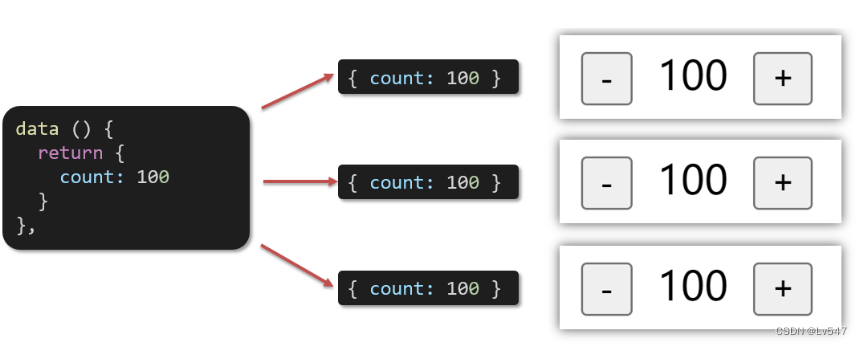
2.代码演示
BaseCount.vue
<template><div class="base-count"><button @click="count--">-</button><span>{{ count }}</span><button @click="count++">+</button></div>
</template><script>
export default {data: function () {return {count: 100,}},
}
</script><style>
.base-count {margin: 20px;
}
</style>
App.vue
<template><div class="app"><BaseCount></BaseCount></div>
</template><script>
import BaseCount from './components/BaseCount'
export default {components: {BaseCount,},
}
</script><style>
</style>
三、组件通信
1.什么是组件通信?
组件通信,就是指组件与组件之间的数据传递
- 组件的数据是独立的,无法直接访问其他组件的数据。
- 想使用其他组件的数据,就需要组件通信
2.组件之间如何通信
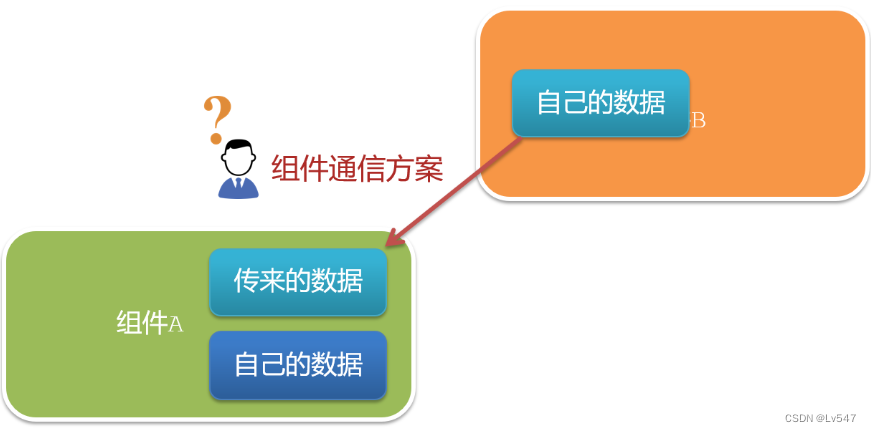
3.组件关系分类
- 父子关系
- 非父子关系

4.通信解决方案
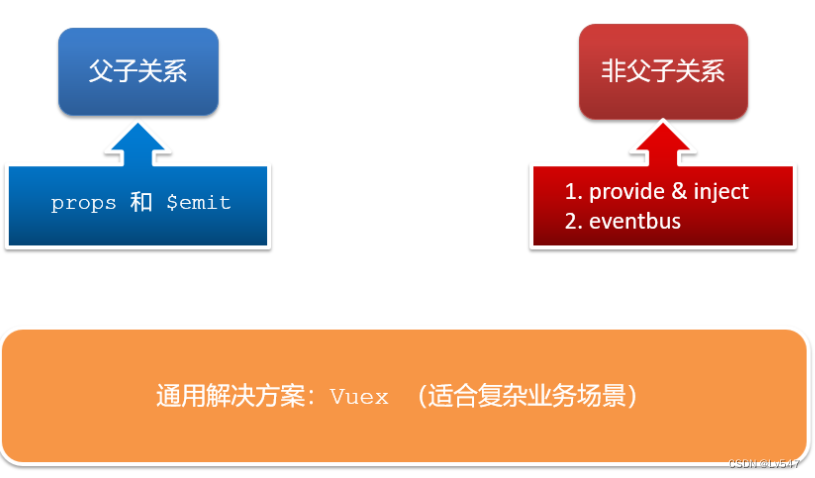
5.父子通信流程
- 父组件通过 props 将数据传递给子组件
- 子组件利用 $emit 通知父组件修改更新
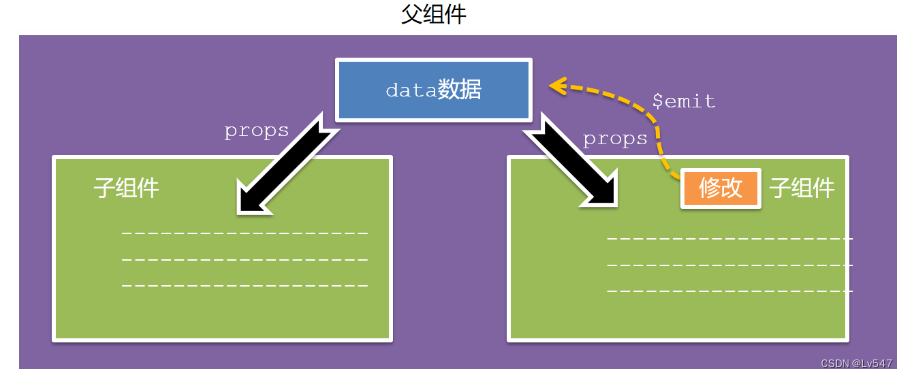
6.父向子通信代码示例
父组件通过props将数据传递给子组件
父组件App.vue
<template><div class="app" style="border: 3px solid #000; margin: 10px">我是APP组件 <Son></Son></div>
</template><script>
import Son from './components/Son.vue'
export default {name: 'App',data() {return {myTitle: '学前端,就来黑马程序员',}},components: {Son,},
}
</script><style>
</style>
子组件Son.vue
<template><div class="son" style="border:3px solid #000;margin:10px">我是Son组件</div>
</template><script>
export default {name: 'Son-Child',
}
</script><style></style>
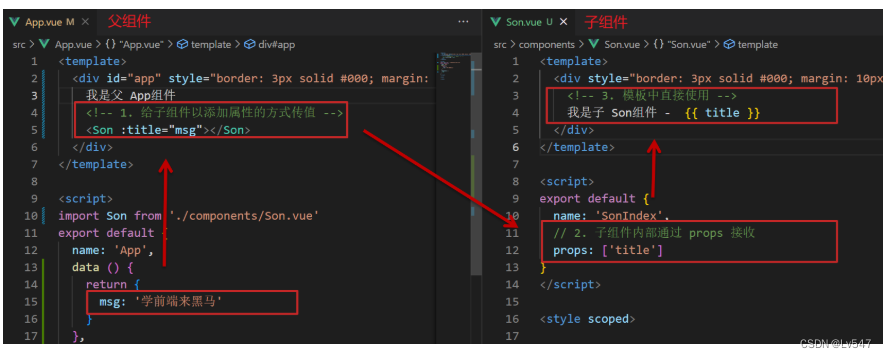
父向子传值步骤
- 给子组件以添加属性的方式传值
- 子组件内部通过props接收
- 模板中直接使用 props接收的值
7.子向父通信代码示例
子组件利用 $emit 通知父组件,进行修改更新
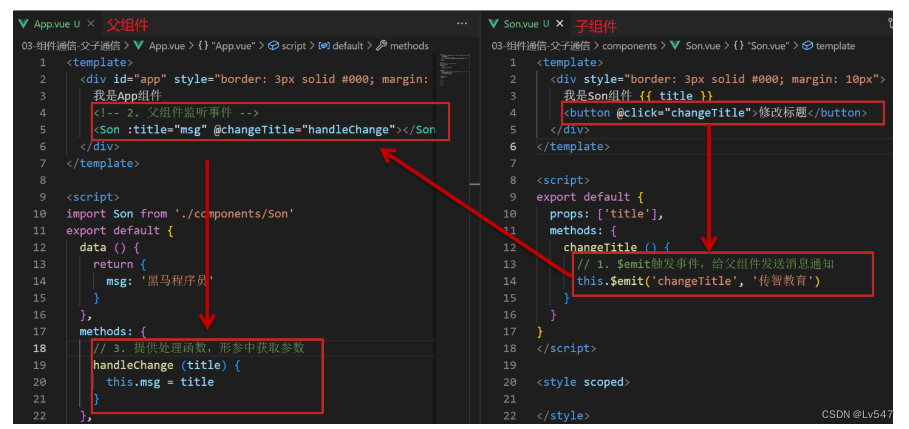
子向父传值步骤
- $emit触发事件,给父组件发送消息通知
- 父组件监听$emit触发的事件
- 提供处理函数,在函数的性参中获取传过来的参数
四、什么是props
1.Props 定义
组件上 注册的一些 自定义属性
2.Props 作用
向子组件传递数据
3.特点
- 可以 传递 任意数量 的prop
- 可以 传递 任意类型 的prop
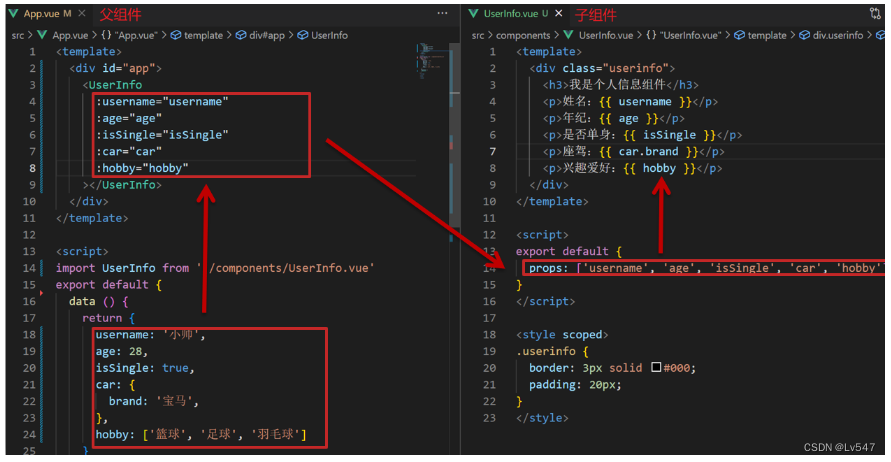
4.代码演示
父组件App.vue
<template><div class="app"><UserInfo:username="username":age="age":isSingle="isSingle":car="car":hobby="hobby"></UserInfo></div>
</template><script>
import UserInfo from './components/UserInfo.vue'
export default {data() {return {username: '小帅',age: 28,isSingle: true,car: {brand: '宝马',},hobby: ['篮球', '足球', '羽毛球'],}},components: {UserInfo,},
}
</script><style>
</style>
子组件UserInfo.vue
<template><div class="userinfo"><h3>我是个人信息组件</h3><div>姓名:</div><div>年龄:</div><div>是否单身:</div><div>座驾:</div><div>兴趣爱好:</div></div>
</template><script>
export default {}
</script><style>
.userinfo {width: 300px;border: 3px solid #000;padding: 20px;
}
.userinfo > div {margin: 20px 10px;
}
</style>
五、props校验
1.思考
组件的props可以乱传吗
2.作用
为组件的 prop 指定验证要求,不符合要求,控制台就会有错误提示 → 帮助开发者,快速发现错误
3.语法
- 类型校验
- 非空校验
- 默认值
- 自定义校验

4.代码演示
App.vue
<template><div class="app"><BaseProgress :w="width"></BaseProgress></div>
</template><script>
import BaseProgress from './components/BaseProgress.vue'
export default {data() {return {width: 30,}},components: {BaseProgress,},
}
</script><style>
</style>
BaseProgress.vue
<template><div class="base-progress"><div class="inner" :style="{ width: w + '%' }"><span>{{ w }}%</span></div></div>
</template><script>
export default {props: ['w'],
}
</script><style scoped>
.base-progress {height: 26px;width: 400px;border-radius: 15px;background-color: #272425;border: 3px solid #272425;box-sizing: border-box;margin-bottom: 30px;
}
.inner {position: relative;background: #379bff;border-radius: 15px;height: 25px;box-sizing: border-box;left: -3px;top: -2px;
}
.inner span {position: absolute;right: 0;top: 26px;
}
</style>
六、props校验完整写法
1.语法
props: {校验的属性名: {type: 类型, // Number String Boolean ...required: true, // 是否必填default: 默认值, // 默认值validator (value) {// 自定义校验逻辑return 是否通过校验}}
},
2.代码实例
<script>
export default {// 完整写法(类型、默认值、非空、自定义校验)props: {w: {type: Number,//required: true,default: 0,validator(val) {// console.log(val)if (val >= 100 || val <= 0) {console.error('传入的范围必须是0-100之间')return false} else {return true}},},},
}
</script>
3.注意
1.default和required一般不同时写(因为当时必填项时,肯定是有值的)
2.default后面如果是简单类型的值,可以直接写默认。如果是复杂类型的值,则需要以函数的形式return一个默认值
七、props&data、单向数据流
1.共同点
都可以给组件提供数据
2.区别
- data 的数据是自己的 → 随便改
- prop 的数据是外部的 → 不能直接改,要遵循 单向数据流
3.单向数据流:
父级props 的数据更新,会向下流动,影响子组件。这个数据流动是单向的
4.代码演示
App.vue
<template><div class="app"><BaseCount></BaseCount></div>
</template><script>
import BaseCount from './components/BaseCount.vue'
export default {components:{BaseCount},data(){},
}
</script><style></style>
BaseCount.vue
<template><div class="base-count"><button @click="count--">-</button><span>{{ count }}</span><button @click="count++">+</button></div>
</template><script>
export default {// 1.自己的数据随便修改 (谁的数据 谁负责)data () {return {count: 100,}},// 2.外部传过来的数据 不能随便修改//props: {// count: {// type: Number,// }, //}
}
</script><style>
.base-count {margin: 20px;
}
</style>
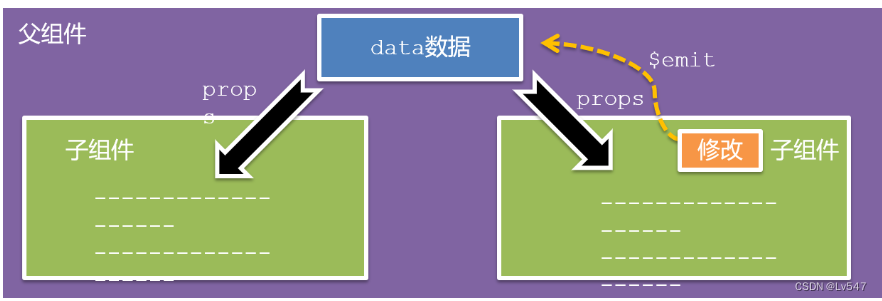
5.口诀
谁的数据谁负责
八、非父子通信-event bus 事件总线
1.作用
非父子组件之间,进行简易消息传递。(复杂场景→ Vuex)
2.步骤
-
创建一个都能访问的事件总线 (空Vue实例)
import Vue from 'vue' const Bus = new Vue() export default Bus -
A组件(接受方),监听Bus的 $on事件
created () {Bus.$on('sendMsg', (msg) => {this.msg = msg}) } -
B组件(发送方),触发Bus的$emit事件
Bus.$emit('sendMsg', '这是一个消息')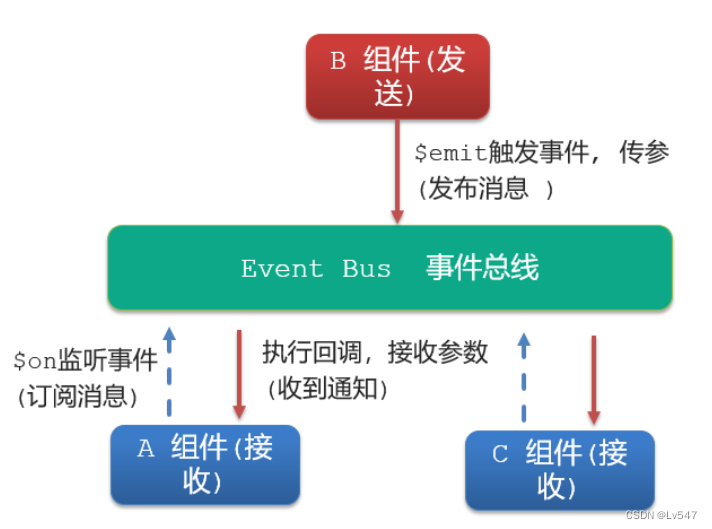
3.代码示例
EventBus.js
import Vue from 'vue'
const Bus = new Vue()
export default Bus
BaseA.vue(接受方)
<template><div class="base-a">我是A组件(接收方)<p>{{msg}}</p> </div>
</template><script>
import Bus from '../utils/EventBus'
export default {data() {return {msg: '',}},
}
</script><style scoped>
.base-a {width: 200px;height: 200px;border: 3px solid #000;border-radius: 3px;margin: 10px;
}
</style>
BaseB.vue(发送方)
<template><div class="base-b"><div>我是B组件(发布方)</div><button>发送消息</button></div>
</template><script>
import Bus from '../utils/EventBus'
export default {
}
</script><style scoped>
.base-b {width: 200px;height: 200px;border: 3px solid #000;border-radius: 3px;margin: 10px;
}
</style>
App.vue
<template><div class="app"><BaseA></BaseA><BaseB></BaseB> </div>
</template><script>
import BaseA from './components/BaseA.vue'
import BaseB from './components/BaseB.vue'
export default {components:{BaseA,BaseB}
}
</script><style></style>
4.总结
1.非父子组件传值借助什么?
2.什么是事件总线
3.发送方应该调用事件总线的哪个方法
4.接收方应该调用事件总线的哪个方法
5.一个组件发送数据,可不可以被多个组件接收
九、非父子通信-provide&inject
1.作用
跨层级共享数据
2.场景
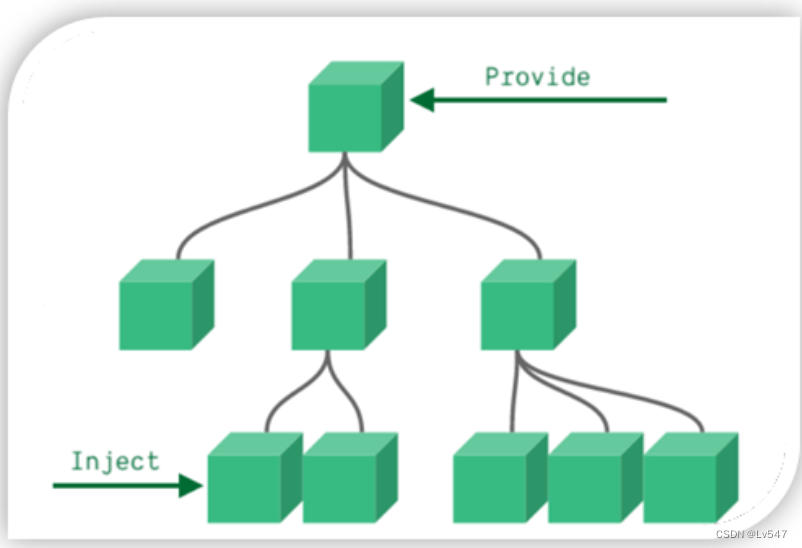
3.语法
- 父组件 provide提供数据
export default {provide () {return {// 普通类型【非响应式】color: this.color, // 复杂类型【响应式】userInfo: this.userInfo, }}
}
2.子/孙组件 inject获取数据
export default {inject: ['color','userInfo'],created () {console.log(this.color, this.userInfo)}
}
4.注意
- provide提供的简单类型的数据不是响应式的,复杂类型数据是响应式。(推荐提供复杂类型数据)
- 子/孙组件通过inject获取的数据,不能在自身组件内修改
十、v-model原理
1.原理:
v-model本质上是一个语法糖。例如应用在输入框上,就是value属性 和 input事件 的合写
<template><div id="app" ><input v-model="msg" type="text"><input :value="msg" @input="msg = $event.target.value" type="text"></div>
</template>2.作用:
提供数据的双向绑定
- 数据变,视图跟着变 :value
- 视图变,数据跟着变 @input
3.注意
$event 用于在模板中,获取事件的形参
4.代码示例
<template><div class="app"><input type="text" /><br /> <input type="text" /></div>
</template><script>
export default {data() {return {msg1: '',msg2: '',}},
}
</script>
<style>
</style>
5.v-model使用在其他表单元素上的原理
不同的表单元素, v-model在底层的处理机制是不一样的。比如给checkbox使用v-model
底层处理的是 checked属性和change事件。
不过咱们只需要掌握应用在文本框上的原理即可
十一、表单类组件封装
1.需求目标
实现子组件和父组件数据的双向绑定 (实现App.vue中的selectId和子组件选中的数据进行双向绑定)
2.代码演示
App.vue
<template><div class="app"><BaseSelect></BaseSelect></div>
</template><script>
import BaseSelect from './components/BaseSelect.vue'
export default {data() {return {selectId: '102',}},components: {BaseSelect,},
}
</script><style>
</style>
BaseSelect.vue
<template><div><select><option value="101">北京</option><option value="102">上海</option><option value="103">武汉</option><option value="104">广州</option><option value="105">深圳</option></select></div>
</template><script>
export default {
}
</script><style>
</style>
十二、v-model简化代码
1.目标:
父组件通过v-model 简化代码,实现子组件和父组件数据 双向绑定
2.如何简化:
v-model其实就是 :value和@input事件的简写
- 子组件:props通过value接收数据,事件触发 input
- 父组件:v-model直接绑定数据
3.代码示例
子组件
<select :value="value" @change="handleChange">...</select>
props: {value: String
},
methods: {handleChange (e) {this.$emit('input', e.target.value)}
}
父组件
<BaseSelect v-model="selectId"></BaseSelect>
十三、.sync修饰符
1.作用
可以实现 子组件 与 父组件数据 的 双向绑定,简化代码
简单理解:子组件可以修改父组件传过来的props值
2.场景
封装弹框类的基础组件, visible属性 true显示 false隐藏
3.本质
.sync修饰符 就是 :属性名 和 @update:属性名 合写
4.语法
父组件
//.sync写法
<BaseDialog :visible.sync="isShow" />
--------------------------------------
//完整写法
<BaseDialog :visible="isShow" @update:visible="isShow = $event"
/>
子组件
props: {visible: Boolean
},this.$emit('update:visible', false)
5.代码示例
App.vue
<template><div class="app"><button @click="openDialog">退出按钮</button><BaseDialog :isShow="isShow"></BaseDialog></div>
</template><script>
import BaseDialog from './components/BaseDialog.vue'
export default {data() {return {isShow: false,}},components: {BaseDialog,},
}
</script><style>
</style>
BaseDialog.vue
<template><div class="base-dialog-wrap" v-show="isShow"><div class="base-dialog"><div class="title"><h3>温馨提示:</h3><button class="close">x</button></div><div class="content"><p>你确认要退出本系统么?</p></div><div class="footer"><button>确认</button><button>取消</button></div></div></div>
</template><script>
export default {props: {isShow: Boolean,}
}
</script><style scoped>
.base-dialog-wrap {width: 300px;height: 200px;box-shadow: 2px 2px 2px 2px #ccc;position: fixed;left: 50%;top: 50%;transform: translate(-50%, -50%);padding: 0 10px;
}
.base-dialog .title {display: flex;justify-content: space-between;align-items: center;border-bottom: 2px solid #000;
}
.base-dialog .content {margin-top: 38px;
}
.base-dialog .title .close {width: 20px;height: 20px;cursor: pointer;line-height: 10px;
}
.footer {display: flex;justify-content: flex-end;margin-top: 26px;
}
.footer button {width: 80px;height: 40px;
}
.footer button:nth-child(1) {margin-right: 10px;cursor: pointer;
}
</style>
6.总结
1.父组件如果想让子组件修改传过去的值 必须加什么修饰符?
2.子组件要修改父组件的props值 必须使用什么语法?
十四、ref和$refs
1.作用
利用ref 和 $refs 可以用于 获取 dom 元素 或 组件实例
2.特点:
查找范围 → 当前组件内(更精确稳定)
3.语法
1.给要获取的盒子添加ref属性
<div ref="chartRef">我是渲染图表的容器</div>
2.获取时通过 $refs获取 this.$refs.chartRef 获取
mounted () {console.log(this.$refs.chartRef)
}
4.注意
之前只用document.querySelect(‘.box’) 获取的是整个页面中的盒子
5.代码示例
App.vue
<template><div class="app"><BaseChart></BaseChart></div>
</template><script>
import BaseChart from './components/BaseChart.vue'
export default {components:{BaseChart}
}
</script><style>
</style>
BaseChart.vue
<template><div class="base-chart-box" ref="baseChartBox">子组件</div>
</template><script>
// yarn add echarts 或者 npm i echarts
import * as echarts from 'echarts'export default {mounted() {// 基于准备好的dom,初始化echarts实例var myChart = echarts.init(document.querySelect('.base-chart-box'))// 绘制图表myChart.setOption({title: {text: 'ECharts 入门示例',},tooltip: {},xAxis: {data: ['衬衫', '羊毛衫', '雪纺衫', '裤子', '高跟鞋', '袜子'],},yAxis: {},series: [{name: '销量',type: 'bar',data: [5, 20, 36, 10, 10, 20],},],})},
}
</script><style scoped>
.base-chart-box {width: 400px;height: 300px;border: 3px solid #000;border-radius: 6px;
}
</style>
十五、异步更新 & $nextTick
1.需求
编辑标题, 编辑框自动聚焦
- 点击编辑,显示编辑框
- 让编辑框,立刻获取焦点
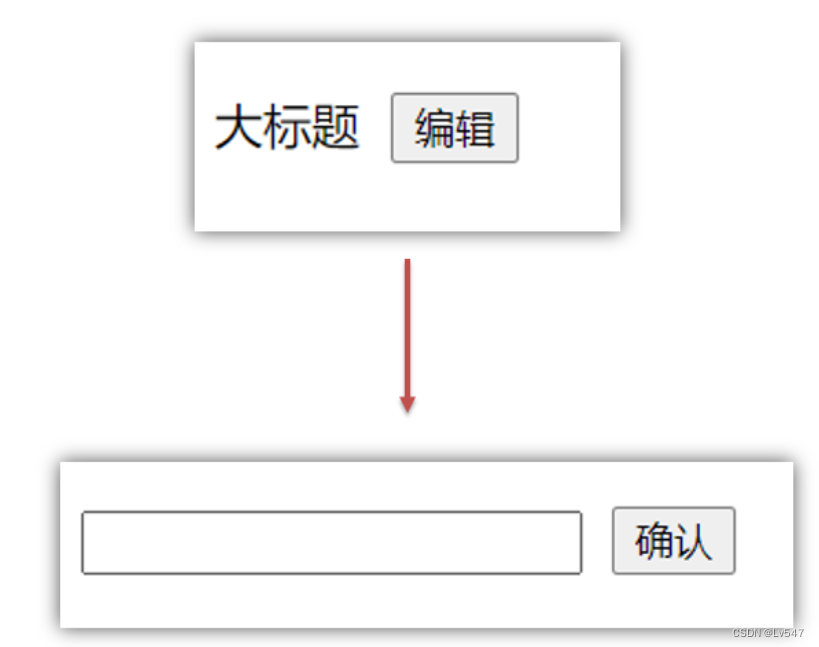
2.代码实现
<template><div class="app"><div v-if="isShowEdit"><input type="text" v-model="editValue" ref="inp" /><button>确认</button></div><div v-else><span>{{ title }}</span><button @click="editFn">编辑</button></div></div>
</template><script>
export default {data() {return {title: '大标题',isShowEdit: false,editValue: '',}},methods: {editFn() {// 显示输入框this.isShowEdit = true // 获取焦点this.$refs.inp.focus() } },
}
</script>
3.问题
“显示之后”,立刻获取焦点是不能成功的!
原因:Vue 是异步更新DOM (提升性能)
4.解决方案
$nextTick:等 DOM更新后,才会触发执行此方法里的函数体
语法: this.$nextTick(函数体)
this.$nextTick(() => {this.$refs.inp.focus()
})
注意:$nextTick 内的函数体 一定是箭头函数,这样才能让函数内部的this指向Vue实例
